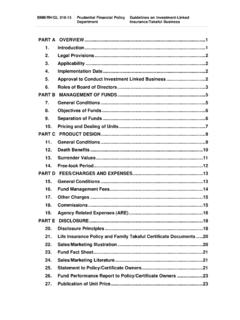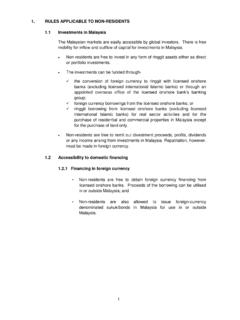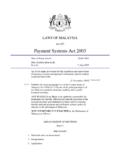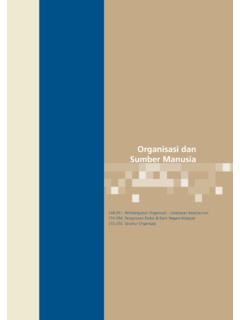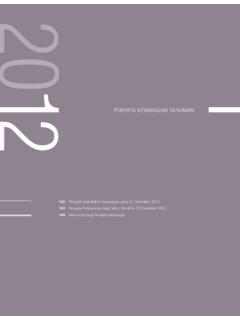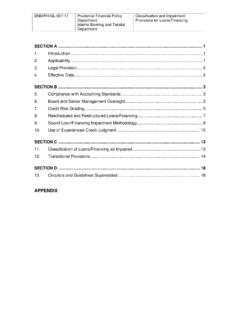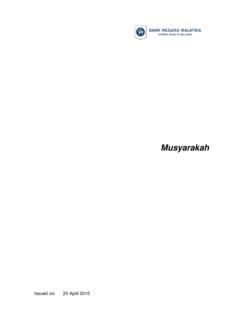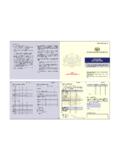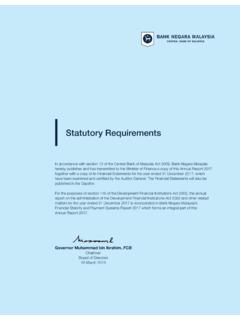Transcription of Capital Adequacy Framework (Capital Components) - BNM
1 Issued on: 9 December 2020 BNM/RH/PD 032-4 Capital Adequacy Framework ( Capital Components) Applicable to: 1. Licensed banks 2. Licensed investment banks 3. financial holding companies Capital Adequacy Framework ( Capital Components) Issued on: 9 December 2020 TABLE OF CONTENTS PART A OVERVIEW .. 1 1 Introduction .. 1 2 Applicability .. 1 3 Legal provisions .. 1 4 Effective date .. 1 5 Interpretation .. 2 6 Related legal instruments and policy documents .. 3 7 Policy document superseded .. 3 PART B GENERAL REQUIREMENTS .. 4 8 Level of application .. 4 9 Capital Adequacy ratios .. 5 10 Minimum Capital Adequacy requirements .. 6 11 Capital buffer requirements .. 6 PART C COMPONENTS OF Capital .. 9 12 Common Equity Tier 1 Capital .. 9 13 Additional Tier 1 Capital .. 9 14 Tier 2 Capital .. 10 PART D CRITERIA FOR INCLUSION IN Capital .. 11 15 Ordinary shares .. 11 16 Additional Tier 1 Capital instruments.
2 12 17 Tier 2 Capital instruments .. 15 18 Minority interest and Capital instruments issued out of consolidated subsidiaries and held by third parties .. 16 PART E REGULATORY ADJUSTMENTS .. 20 19 Goodwill and other intangibles .. 20 20 Deferred tax assets and liabilities .. 20 21 Property revaluation gains/losses .. 20 22 Cumulative gains/losses of financial instruments measured at fair value through other comprehensive income or designated at fair value .. 21 23 Cash flow hedge reserve .. 21 24 Regulatory reserve .. 21 25 Shortfall of eligible provisions to expected losses .. 22 26 Valuation adjustments .. 22 27 Increases in equity Capital resulting from a securitisation transaction .. 22 28 Cumulative gains/losses due to changes in own credit risk on fair valued liabilities .. 22 29 Defined benefit pension fund assets and liabilities .. 22 30 Investments in own Capital instruments .. 23 31 Investments in the Capital of unconsolidated financial and insurance/ takaful entities.
3 24 32 Other regulatory adjustments .. 25 Capital Adequacy Framework ( Capital Components) Issued on: 9 December 2020 PART F OTHER REQUIREMENTS .. 27 33 Requirements to ensure loss absorbency at the point of non-viability .. 27 34 Write-off or conversion mechanisms for achieving principal loss absorption and/or loss absorbency at the point of non-viability .. 28 35 Disclosure requirements .. 29 36 Regulatory process and submission requirements .. 30 37 Statistical reporting requirements .. 32 PART G TRANSITIONAL ARRANGEMENTS .. 33 38 Transitional arrangements for banking institutions .. 33 39 Transitional arrangements for financial institutions .. 36 APPENDICES .. 39 General treatment of equity investments .. 39 Illustration of minority interest and Capital instruments issued out of consolidated subsidiaries held by third parties .. 40 Transitional arrangements for Capital instruments .. 43 Illustration of the gradual phase-out treatment .
4 45 Write-off mechanism for Additional Tier 1 and Tier 2 Capital instruments .. 47 Illustration of transitional arrangements for provisions for expected credit losses (ECLs) .. 48 Capital Adequacy Framework ( Capital Components) 1 of 51 Issued on: 9 December 2020 PART A OVERVIEW 1 Introduction Regulatory Capital requirements seek to ensure that risk exposures of a financial institution are backed by an adequate amount of high quality Capital which absorbs losses on a going concern basis. This ensures the continuing ability of a financial institution to meet its obligations as they fall due while also maintaining the confidence of customers, depositors, creditors and other stakeholders in their dealings with the institution. Capital requirements also seek to further protect depositors and other senior creditors in a gone concern situation by promoting an additional cushion of assets that may be used to meet claims in liquidation.
5 Policy objective The Capital Adequacy Framework sets out the approach for computing regulatory Capital Adequacy ratios, as well as the levels of those ratios at which a financial institution is required to operate. The Framework has been developed based on internationally-agreed standards on Capital Adequacy promulgated by the Basel Committee on Banking Supervision (BCBS). Scope of policy This policy document sets out the general requirements concerning regulatory Capital Adequacy , and the components of eligible regulatory Capital . It shall be read together with the policy document on Capital Adequacy Framework (Basel II Risk-Weighted Assets) which details out the requirements for computing risk-weighted assets and other relevant legal instruments and policy documents that have been issued by the Bank. 2 Applicability This policy document is applicable to financial institutions as defined in paragraph 3 Legal provisions This policy document is specified pursuant to section 47 (2), section 51, section 115, section 143 (2), and section 266 of the financial Services Act 2013 (FSA).
6 4 Effective date This policy document comes into effect (a) on 9 December 2020 for a banking institution, subject to the transitional arrangements as set out in paragraphs 38 and 39; and (b) on 9 December 2020 for a financial holding company, subject to the transitional arrangements as set out in paragraph 39. Capital Adequacy Framework ( Capital Components) 2 of 51 Issued on: 9 December 2020 5 Interpretation The terms and expression used in this policy document shall have the same meanings assigned to them in the FSA, unless otherwise defined in this policy document. For the purpose of this policy document S denotes a standard, an obligation, a requirement, specification, direction, condition and any interpretative, supplemental and transitional provisions that must be complied with. Non-compliance may result in enforcement actions; G denotes guidance which may consist of statements or information intended to promote common understanding and advice or recommendations that are encouraged to be adopted; banking institution means a licensed bank or a licensed investment bank, as the case may be; financial group refers to a licensed bank and its subsidiaries, a licensed investment bank and its subsidiaries, or a financial holding company and its subsidiaries, as the case may be; financial holding company refers to a financial holding company approved pursuant to section 112(3) of the FSA and holds investment directly or indirectly in corporations that are engaged predominantly in banking business; financial institution means a banking institution or financial holding company, as the case may be.
7 financial subsidiary/entity refers to any entity, whether incorporated in or outside Malaysia, engaged substantively in, or acquiring holdings in other entities engaged substantively in, any of the following activities: banking, provision of credit, securities broking, fund management, asset management, leasing and factoring and similar activities that are ancillary to the conduct of these activities; general provision refers to (i) loss allowance measured at an amount equal to 12-month and lifetime expected credit losses1; and (ii) regulatory reserves2, to the extent they are ascribed to non-credit-impaired exposures. 1 Refer to mfrs 9 financial Instruments. For the avoidance of doubt, these provisions are also commonly known as Stage 1 and Stage 2 provisions respectively. 2 Refer to the policy document on financial reporting . Capital Adequacy Framework ( Capital Components) 3 of 51 Issued on: 9 December 2020 6 Related legal instruments and policy documents This policy document must be read together with other relevant instruments and policy documents that have been issued by the Bank, in particular (a) Policy document on Capital Adequacy Framework (Basel II Risk-Weighted Assets) issued on 3 May 2019; (b) Policy document on Capital Adequacy Framework for Islamic Banks ( Capital Components) issued on 9 December 2020; (c) Policy document on Domestic Systemically Important Banks Framework issued on 5 February 2020; (d) Policy document on financial reporting issued on 27 September 2019; (e) Policy document on Guidelines on Skim Perbankan Islam issued on 2 November 2012; (f) Policy document on Investment Account issued on 17 January 2018.
8 (g) Policy document on Risk Weighted Capital Adequacy Framework (Basel II) Disclosure Requirements (Pillar 3) issued on 7 August 2010; and (h) Policy document on STAT smart reporting Requirements on Data Submission for reporting Entities issued on 29 March 2019. 7 Policy document superseded This policy document supersedes the policy document on Capital Adequacy Framework ( Capital Components) issued on 5 February 2020. Capital Adequacy Framework ( Capital Components) 4 of 51 Issued on: 9 December 2020 PART B GENERAL REQUIREMENTS 8 Level of application S A banking institution shall comply with the Capital Adequacy requirements in this policy document at the following levels: (a) entity level3, referring to the global operations of the banking institution ( including its overseas branch operations) on a stand-alone basis, and including its Labuan banking subsidiary; and (b) consolidated level, which includes entities covered under the entity level requirement, and the consolidation4 of all financial and non- financial subsidiaries, except insurance/takaful subsidiaries which shall be deducted in the calculation of Common Equity Tier 1 Capital5.
9 S A financial holding company shall comply with the Capital Adequacy requirements in this policy document at the consolidated level in accordance with paragraph (b). S Where consolidation of the subsidiaries required under paragraphs (b) and is not feasible6, a financial institution shall seek the Bank s approval to (a) in the case of a financial subsidiary, deduct such investments in accordance with paragraph ; and (b) in the case of a non- financial subsidiary, apply a risk weight of 1250% to such investments in accordance with paragraphs , and of the policy document on Capital Adequacy Framework (Basel II Risk-Weighted Assets). S In addition to paragraph (a), a banking institution carrying on Skim Perbankan Islam7 (hereafter referred to as an SPI ), shall comply with the requirements under the policy document on Capital Adequacy Framework for Islamic Banks ( Capital Components) at the level of the SPI, as if it were a stand-alone Islamic bank.
10 S A summary of the general treatment referred to in paragraphs to , as well as that applicable for other equity investments, is set out in Appendix 1. 3 Also referred to as the solo or stand-alone level. 4 In accordance with the malaysian financial reporting standards ( mfrs ). 5 In accordance with paragraph 6 For example, where non-consolidation for regulatory Capital purposes is otherwise required by law. 7 In accordance with section 15 of the FSA and Guidelines on Skim Perbankan Islam. Capital Adequacy Framework ( Capital Components) 5 of 51 Issued on: 9 December 2020 9 Capital Adequacy ratios S A financial institution shall calculate its Common Equity Tier 1 (CET1) Capital , Tier 1 Capital and Total Capital Ratios in the following manner: (a) (b) (c) S For the purpose of paragraph (a) the numerators of the Capital Adequacy ratios are defined in accordance with the following: (i) CET1 Capital as defined in paragraph ; (ii) Tier 1 Capital shall be the sum of CET1 Capital and Additional Tier 1 Capital as defined in paragraph ; and (iii) Total Capital shall be the sum of Tier 1 Capital and Tier 2 Capital as defined in paragraph.
